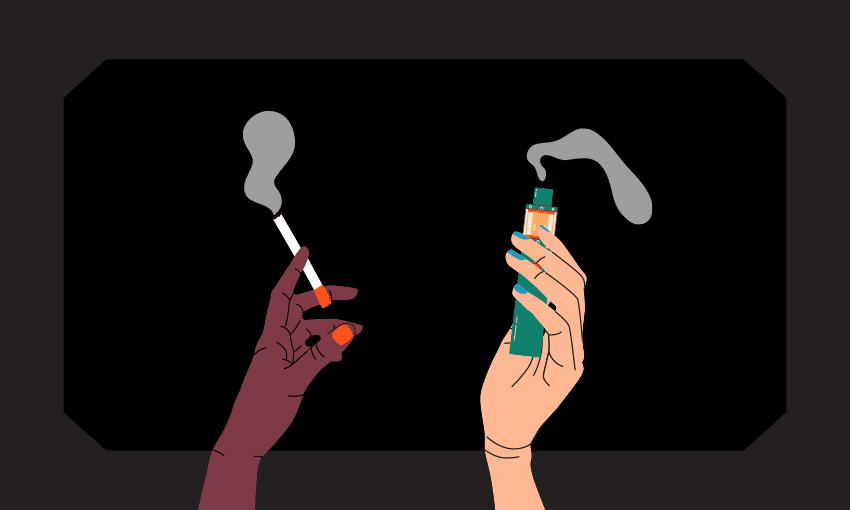A new study has found vaping might be hindering progress in reducing smoking rates among teenagers in Aotearoa.
What’s all this then?
A new study has found the rise of vaping in Aotearoa might actually be hindering progress in reducing smoking rates, while continuing to widen the gap in health equity for Māori and Pacific young people. The study, carried out by researchers from Auckland, Otago and Sydney universities and published in The Lancet Regional Health – Western Pacific, analysed data collected from nearly 600,000 young people aged 14 and 15 over the last two decades in Aotearoa to find out how the introduction of vaping impacted smoking rates across various ethnic groups.
But wait, I thought our smoking rates were going great?
Yes, smoking has been in steady decline in Aotearoa, especially over the last decade. In 2011, 16.4% of adults 15+ were daily smokers, compared to just 6.9%, or 573,000 people down to 300,000 in 2024. The number of Māori adults who smoke daily is now at 14.7%, down from 37.3% in 2011, with Pacific smokers also down from 22.6% in 2011 to 12.3%. The number of young people aged 18-24 who smoke daily is now at 4.2% (down from 24.6% in 2011). This decline in smoking has been helped by key policies introduced such as smokefree cars with child passengers, point-of-sale display bans and plain packaging on cigarette cartons.
A vape store display in the US (Photo: Getty Images. Design: Archi Banal)
So what’s vaping got to do with this?
Comparing smoking trends from 2003 to 2009 (AKA before vaping arrived in Aotearoa) with data from 2010 to 2024 (when vaping became common), the study found that the arrival of vaping slowed the decline in smoking rates. If the downward trend as recorded in the noughties had continued, the numbers should now be sitting at 4.2% for Māori, 1.8% for Pacific, and 0.7% for European adolescents. Alas, in 2024, regular smoking rates were actually 6.2% for Māori, 3.3% for Pacific, and 2% for European teenagers.
“The emergence of vaping appears to have undermined progress in reducing regular smoking, especially among Māori and Pacific youth who were already facing disproportionate tobacco-related harm,” said Lucy Hardie, a population health researcher at Waipapa Taumata Rau/University of Auckland who contributed to the study. “Not only has vaping not accelerated progress to reduce smoking, but Māori and Pacific youth are also experiencing more harms related to vaping and nicotine addiction – like the cycle of withdrawal and craving which can really impact your daily life.”
But didn’t people reckon vaping was going to help people quit smoking?
Yes: vape kits are given to smokers trying to kick the habit because vaping is “a less harmful form of nicotine delivery compared to combusted tobacco”, according to Te Whatu Ora. While there is some evidence it is helping, the new study isn’t the first to find flaws in the method: a 2023 University of Otago study suggested those who vape were “just as likely to transition to smoking as smokers were to transition to vaping”.
(Image: Tina Tiller)
So what do these findings mean for Māori in particular?
Māori health researcher and associate professor Andrew Waa from the University of Otago said the study was especially concerning for Māori and Pacific youth, who already have much higher rates of smoking and vaping than their peers. “We sometimes hear that e-cigarettes might be a harm-reduction device for Māori and Pacific youth, by reducing or stopping them from smoking,” Waa said. “Our study shows the opposite. Rather than supporting claims that vaping reduces harms for Māori and Pacific youth, vaping has substantially added to them.”
As the study notes, the harms associated with nicotine, regardless of whether it comes from vapes, e-cigarettes or tobacco, extend beyond physical health and negatively affect social, cultural and psychological wellbeing as well. “Prior to European colonisation, Maori were a culture free from addiction. With colonisation, tobacco was introduced as a trade commodity, and since then, nicotine addiction has continued to undermine Maori self-determination (tino rangatiratanga), while also serving as a persistent reminder of colonisation,” it reads.
What should happen next?
While stricter rules have recently been brought in in an effort to reduce the appeal of vaping to young people, Hardie told The Spinoff this should be a bigger focus. “When you look at how the industry continuously markets to young people, it just doesn’t seem like there’s any surprises there that the uptake of vaping is huge among young people,” she said. “I would also really like to see a reduction in flavours, and a reduction in the places that you can buy them because they’re so readily available – the dairy, alcohol outlets, gas stations… you name it, it’s absolutely everywhere.”
Waa added that urgent action was needed to align policy with obligations under te Tiriti o Waitangi. “Policies that enable easy access to vaping products don’t just miss the mark on health – they also fall short of te Tiriti o Waitangi commitments and Aotearoa’s international obligations to address inequities affecting indigenous peoples.”
Is there any good news out there about vaping this week?
All I could find was this story about how a fast-acting anaesthetic has been detected in vape products across the country, resulting in seizures, sedation, breathing difficulties and a small number of hospitalisations to date. Sorry.

